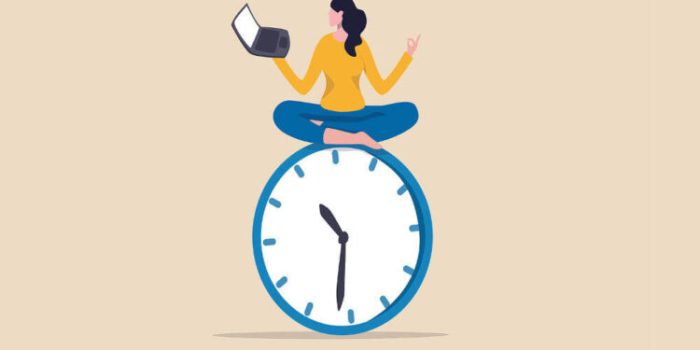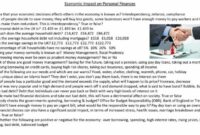Managing time effectively in a demanding modern lifestyle is more than just juggling tasks; it’s about crafting a life that feels balanced and fulfilling. In today’s fast-paced world, overflowing inboxes, constant notifications, and the pressure to do it all can leave us feeling overwhelmed and depleted. This exploration delves into practical strategies and mindset shifts to help you navigate the complexities of modern life and reclaim control of your time, ultimately leading to increased productivity and a greater sense of well-being.
We’ll explore proven techniques for identifying time-wasting activities, prioritizing effectively, and leveraging technology to your advantage. We’ll also examine the crucial role of self-care and stress management in maintaining sustainable productivity. Ultimately, this guide aims to equip you with the tools and knowledge to not just manage your time, but to master it, creating a life that truly reflects your values and aspirations.
Defining “Effective Time Management” in a Demanding Lifestyle
Effective time management in a demanding lifestyle isn’t about cramming more into your day; it’s about prioritizing what truly matters and working smarter, not harder. It’s about achieving a fulfilling balance between personal life, professional obligations, and self-care, all while navigating the constant pressures of a fast-paced world.The unique challenges of modern life significantly impact our ability to manage time effectively.
The constant connectivity afforded by technology, while offering convenience, often leads to distractions and an always-on mentality. Blurred lines between work and personal life, coupled with increased demands from both spheres, create a perpetual feeling of being overwhelmed. The sheer volume of information and competing priorities further complicate the process, making it difficult to focus on what truly requires attention.
Furthermore, unexpected events and emergencies can easily derail even the most meticulously planned schedules.
Traditional vs. Modern Time Management Techniques
Traditional time management techniques, often relying on rigid schedules and to-do lists, can feel inadequate in the face of today’s dynamic environment. These methods, while helpful in providing structure, often fail to account for the inherent unpredictability of modern life. For example, rigidly scheduling every minute of the day can lead to frustration when unforeseen circumstances arise, causing stress and a sense of failure.Modern approaches to time management emphasize flexibility and adaptability.
Juggling work, family, and personal life in today’s fast-paced world can be tough. Effective time management is key, and sometimes, the best way to recharge is through a well-deserved break. Consider exploring unique opportunities like those offered by Luxury lifestyle travel experiences for solo travelers , allowing you to return refreshed and ready to tackle your demanding schedule with renewed focus and energy.
Prioritizing self-care, even in small ways, contributes significantly to better time management overall.
Techniques like time blocking, which allocates specific time slots for particular tasks, are more effective than rigid scheduling, allowing for adjustments based on changing priorities. The Pomodoro Technique, involving focused work sessions interspersed with short breaks, helps maintain concentration and prevents burnout. Prioritization matrices, such as the Eisenhower Matrix (urgent/important), aid in identifying and focusing on high-impact tasks.
These methods acknowledge the unpredictable nature of modern life and provide frameworks for adapting to unexpected events and changes in priorities. Instead of fighting against the constant flux, these techniques embrace it, allowing for a more sustainable and less stressful approach to time management.
Identifying Time Wasters and Inefficiencies
Effective time management hinges on understanding where your time actually goes. Many of us feel perpetually busy, yet struggle to achieve our goals. This often stems from a lack of awareness regarding our daily habits and the subtle ways time slips away. Identifying and addressing these time drains is crucial for reclaiming control of your schedule and boosting productivity.We’ll explore common time-wasting activities and provide a practical self-assessment tool to help you pinpoint your personal productivity bottlenecks.
Then, we’ll offer strategies to minimize distractions and interruptions.
Common Time-Wasting Activities in Modern Lifestyles
Modern life presents a unique set of time challenges. Many activities, while seemingly innocuous, can significantly impact productivity if not managed effectively. Constant notifications, readily available entertainment, and poorly structured workflows contribute to a feeling of being overwhelmed and perpetually behind.
Self-Assessment Tool for Identifying Personal Time Wasters
To effectively manage your time, you must first understand how you currently spend it. This self-assessment will help you identify your personal time-wasting habits. For a week, track your activities in hourly blocks. Categorize each activity as either productive (directly contributing to your goals), necessary (essential but not directly goal-oriented), or unproductive (not contributing to your goals and easily avoidable).
Analyze your results at the end of the week to identify patterns and areas for improvement. For example, if you consistently spend two hours a day on social media, you might consider setting time limits or scheduling specific times for social media engagement.
Strategies for Minimizing Distractions and Interruptions
Minimizing distractions is vital for focused work. Strategies range from simple adjustments to your environment to employing technology to your advantage. The following table provides specific examples and estimated time savings.
| Distraction | Impact | Mitigation Strategy | Time Saved (per week) |
|---|---|---|---|
| Social Media Notifications | Constant interruptions disrupt focus and workflow. | Turn off non-essential notifications during work periods. Use website blockers or app timers. | 5-10 hours |
| Unproductive Meetings | Wasted time due to poor agendas, lack of preparation, and rambling discussions. | Prepare agendas beforehand, stick to them, and encourage concise communication. Consider alternative communication methods (email) for less critical updates. | 2-5 hours |
| Email Overload | Continuous checking leads to context switching and reduces concentration. | Schedule specific times for email checks (e.g., twice a day). Use filters and unsubscribe from unnecessary mailing lists. | 3-7 hours |
| Multitasking | Reduces efficiency and increases error rates. | Focus on one task at a time. Utilize techniques like the Pomodoro Technique (25 minutes of focused work followed by a 5-minute break). | Variable, but significant improvements in quality of work. |
Prioritization and Goal Setting Techniques

Source: magnateview.com
Effective time management hinges on knowing what to do and when to do it. This requires a clear understanding of your goals and the ability to prioritize tasks effectively. Without a well-defined roadmap and a system for managing your workload, even the most diligent efforts can feel unproductive.Setting clear, achievable goals aligned with your personal values is crucial for sustained motivation and a sense of accomplishment.
When your actions directly contribute to something meaningful to you, you’re more likely to stay focused and persevere through challenges. This intrinsic motivation is far more powerful than external pressure. Furthermore, breaking down large, overwhelming goals into smaller, manageable steps reduces feelings of being overwhelmed and makes progress more visible, boosting morale and productivity.
The Importance of SMART Goals
SMART goals provide a framework for creating achievable and measurable objectives. The acronym stands for Specific, Measurable, Achievable, Relevant, and Time-bound. A vague goal like “get healthier” is far less effective than a SMART goal like “lose 10 pounds by June 1st by exercising three times a week and reducing daily sugar intake.” The specificity and measurability of the SMART goal provide clear targets and allow for progress tracking.
Achievability ensures the goal is challenging yet attainable, while relevance confirms it aligns with your broader aspirations. The time-bound element adds urgency and helps to avoid procrastination.
Prioritization Methods: Eisenhower Matrix and Pareto Principle
Several methods can help prioritize tasks. The Eisenhower Matrix, also known as the Urgent-Important Matrix, categorizes tasks based on urgency and importance. Urgent tasks require immediate attention, while important tasks contribute to long-term goals. The matrix helps identify which tasks to do immediately, which to schedule, which to delegate, and which to eliminate.
Juggling work, family, and personal life in today’s fast-paced world requires serious time management skills. Often, we overlook the impact of lifestyle choices on our schedules; for example, the seemingly effortless luxury lifestyle often hides significant time commitments. Check out this article on Hidden costs of maintaining a luxury lifestyle to see how much time these pursuits can consume.
Ultimately, effective time management is key to navigating a demanding lifestyle, regardless of its perceived extravagance.
| Urgent | Not Urgent | |
|---|---|---|
| Important | Do First | Schedule |
| Not Important | Delegate | Eliminate |
The Pareto Principle, or the 80/20 rule, suggests that 80% of your results come from 20% of your efforts. Identifying and focusing on that crucial 20% maximizes your impact. For example, if 20% of your clients generate 80% of your revenue, prioritizing those clients ensures you’re focusing your energy where it matters most.
A Step-by-Step Guide to Setting SMART Goals
- Identify your values: What’s truly important to you? Your goals should align with these values.
- Brainstorm potential goals: Consider areas of your life you want to improve – work, health, relationships, personal growth.
- Select one or two primary goals: Focus your energy to avoid spreading yourself too thin.
- Apply the SMART criteria: Make sure each goal is Specific, Measurable, Achievable, Relevant, and Time-bound.
- Break down the goals into smaller tasks: Create a detailed plan with actionable steps.
- Schedule time for each task: Allocate specific time slots in your calendar to work on each task.
- Review and adjust as needed: Regularly assess your progress and make necessary adjustments to your plan.
For example, let’s say your goal is to write a novel (Specific). You could measure progress by the number of pages written per week (Measurable). You might set a goal of writing 10 pages a week, which is achievable if you allocate consistent writing time (Achievable and Time-bound). If writing a novel aligns with your creative aspirations, it’s relevant (Relevant).
Planning and Scheduling Strategies
Effective planning and scheduling are the cornerstones of successful time management. They provide a framework for prioritizing tasks, allocating time efficiently, and ensuring that both professional and personal goals are met. Without a well-defined plan, even the most diligent individual can easily feel overwhelmed and unproductive. Choosing the right tools and techniques is crucial to creating a system that works for you.Planning and scheduling involve more than just writing down appointments; it’s about strategically allocating time to maximize productivity and minimize stress.
This involves understanding your personal rhythms, identifying peak performance periods, and building buffer time to account for unexpected events. The goal is to create a realistic and sustainable schedule that promotes balance and well-being.
Different Planning Tools and Their Benefits
The choice between digital calendars and paper planners often comes down to personal preference and working style. Digital calendars, such as those integrated into smartphones or computers, offer features like reminders, notifications, and easy sharing. They are highly portable and allow for quick updates. However, some find the constant notifications distracting, and reliance on technology can be a drawback if there’s a power outage or device malfunction.
Paper planners, on the other hand, provide a tangible visual representation of your schedule and can be more satisfying for some individuals. The act of physically writing down tasks can aid memory and focus. However, paper planners lack the flexibility and automated features of digital counterparts.
Sample Weekly Schedule
A well-balanced weekly schedule incorporates work, personal commitments, and leisure time. Here’s an example:
- Monday: 8:00 AM – 5:00 PM: Work (including a 1-hour lunch break and short breaks throughout the day); 6:00 PM – 7:00 PM: Gym; 7:30 PM: Dinner with family.
- Tuesday: 8:00 AM – 5:00 PM: Work; 6:00 PM – 7:00 PM: Prepare meals for the week; 7:30 PM: Relax and unwind.
- Wednesday: 8:00 AM – 5:00 PM: Work; 6:00 PM: Attend a virtual meeting; 7:30 PM: Personal time (reading, hobbies).
- Thursday: 8:00 AM – 5:00 PM: Work; 6:00 PM: Grocery shopping; 7:30 PM: Spend time with friends.
- Friday: 8:00 AM – 1:00 PM: Work; 2:00 PM – 4:00 PM: Errands; 5:00 PM onwards: Weekend preparation.
- Saturday: Personal time, hobbies, social activities.
- Sunday: Relaxing activities, meal preparation for the week, planning for the upcoming week.
This is just a sample, and individual schedules will vary depending on personal circumstances and preferences. The key is to ensure that all important aspects of life are represented.
Blocking Out Time for Focused Work and Avoiding Over-Scheduling
Time blocking involves scheduling specific tasks or activities within designated time slots. This technique promotes focused work by minimizing distractions and interruptions. For instance, dedicate 90 minutes to a complex project, followed by a short break. This approach leverages the Pomodoro Technique principles, which have shown improved concentration and productivity. Avoid over-scheduling by leaving buffer time between appointments and tasks.
This accounts for unexpected delays or interruptions, preventing a domino effect of schedule disruptions. Realistic scheduling is crucial; it’s better to slightly under-schedule and have some free time than to constantly feel rushed and stressed. Remember to incorporate breaks and leisure activities to maintain a healthy work-life balance.
Stress Management and Self-Care
Effective time management and stress levels are inextricably linked. When we struggle to manage our time, we often feel overwhelmed, leading to increased stress and potentially impacting our physical and mental well-being. Conversely, effectively managing our time can significantly reduce stress and improve our overall quality of life. This section explores the connection between these two factors and provides practical strategies for managing stress and prioritizing self-care within a demanding lifestyle.The relationship between ineffective time management and stress is a vicious cycle.
Feeling constantly rushed and behind schedule triggers the body’s stress response, leading to anxiety, irritability, and even burnout. This stress, in turn, makes it even harder to focus and prioritize tasks, further exacerbating the time management problem. The resulting lack of control over one’s schedule contributes to feelings of helplessness and frustration, adding to the overall stress load.
Stress Reduction Techniques
Implementing stress-reduction techniques is crucial for maintaining both mental and physical health, particularly in demanding lifestyles. These techniques help to counteract the negative effects of stress, improving focus, productivity, and overall well-being. Consistent practice of these methods is key to long-term effectiveness.
- Mindfulness Meditation: Even short periods of mindfulness meditation (5-10 minutes) can significantly reduce stress levels. The practice involves focusing on the present moment, observing thoughts and feelings without judgment. This helps to calm the mind and reduce racing thoughts often associated with stress. Regular practice can improve focus and emotional regulation.
- Regular Exercise: Physical activity is a powerful stress reliever. Exercise releases endorphins, which have mood-boosting effects. Aim for at least 30 minutes of moderate-intensity exercise most days of the week. This could include brisk walking, jogging, cycling, or swimming. The key is to find an activity you enjoy and can stick with.
- Adequate Sleep: Sleep deprivation significantly increases stress hormones. Aim for 7-9 hours of quality sleep each night. Establish a regular sleep schedule, create a relaxing bedtime routine, and ensure your bedroom is dark, quiet, and cool to optimize sleep quality. Prioritizing sleep is an investment in your overall well-being and ability to manage stress effectively.
Sample Self-Care Routine
Integrating self-care into a busy schedule requires intentionality and planning. However, even small acts of self-care can make a significant difference in reducing stress and improving overall well-being. Consistency is key; try to incorporate these elements into your daily or weekly routine.
- Morning Mindfulness: Start the day with 5-10 minutes of meditation or deep breathing exercises.
- Mid-day Movement: Take a short walk or stretch break during your workday to reduce physical tension and improve focus.
- Evening Relaxation: Wind down before bed with a warm bath, reading a book, or listening to calming music. Avoid screen time for at least an hour before sleep.
- Weekly Recharge: Dedicate one day a week to a relaxing activity you enjoy, such as spending time in nature, pursuing a hobby, or socializing with loved ones.
Technology and Time Management Tools
Technology plays a double-edged role in our quest for effective time management. While it offers incredible tools to boost productivity, it can also be a significant source of distraction and inefficiency if not managed properly. The key lies in harnessing technology’s power strategically, choosing the right tools, and establishing healthy boundaries around their usage.The modern landscape offers a plethora of apps and software designed to streamline various aspects of time management.
Juggling work, family, and personal life in today’s fast-paced world requires serious time management skills. Understanding how we spend our time often reveals hidden priorities, and sometimes those priorities are shaped by external factors like aspirational lifestyles. Learning about the psychology behind luxury consumption, as explored in this insightful article, The psychology of luxury lifestyle consumption , can help us better understand our own spending habits and how they impact our time allocation.
Ultimately, effective time management is key to achieving a fulfilling life, whatever that may look like to you.
These range from simple to-do list managers to sophisticated project management platforms, each catering to different needs and working styles. Careful selection is crucial, as using too many tools can ironically lead to more time spent managing the tools than actually working.
Productivity Apps and Software for Time Management
Many applications are designed to assist with time management. These tools vary in complexity and features, but they all aim to help users organize their tasks, track their time, and ultimately become more productive. Effective selection depends on individual preferences and specific needs.
- To-do list apps: These apps, such as Todoist, Any.do, and Microsoft To Do, allow users to create and organize tasks, set deadlines, and prioritize items. They often include features like subtasks, reminders, and collaboration tools. Simpler apps focus on ease of use, while more complex ones offer advanced features like project management capabilities and integration with other services.
- Calendar apps: Google Calendar, Outlook Calendar, and Apple Calendar are examples of widely used calendar applications. These apps allow users to schedule appointments, set reminders, and share calendars with others. Effective use involves blocking out time for specific tasks, minimizing scheduling conflicts, and utilizing features like recurring events and time zone adjustments.
- Time tracking apps: Toggl Track, RescueTime, and Clockify are examples of time tracking apps that allow users to monitor how much time they spend on different tasks. This data can be invaluable for identifying time-wasting activities and improving productivity. Some apps offer advanced features like project tracking and reporting, enabling users to analyze their work patterns and make data-driven improvements.
- Project management software: Asana, Trello, and Monday.com are examples of project management software that provide tools for managing complex projects. These tools often include features such as task assignment, progress tracking, and communication tools. They are particularly useful for teams working on collaborative projects, ensuring everyone stays informed and on track.
Comparing Time Management App Features and Effectiveness, Managing time effectively in a demanding modern lifestyle
The effectiveness of a time management app is highly subjective and depends on individual needs and preferences. There is no single “best” app, but rather a range of options catering to different working styles and levels of complexity. Factors to consider include ease of use, features offered, integration with other services, and overall cost.
| Feature | Simple To-Do List App (e.g., Any.do) | Complex Project Management Software (e.g., Asana) |
|---|---|---|
| Ease of Use | High | Moderate |
| Task Management | Basic task creation, prioritization, and reminders | Advanced task management, subtasks, dependencies, and progress tracking |
| Collaboration | Limited | Extensive collaboration features, including task assignment and communication tools |
| Reporting and Analytics | Minimal | Detailed reporting and analytics on project progress and team performance |
| Cost | Often free with premium options | Usually subscription-based |
Delegation and Outsourcing
In today’s fast-paced world, juggling multiple responsibilities can feel overwhelming. Effective time management isn’t just about personal productivity; it’s also about strategically distributing tasks to maximize efficiency and minimize stress. Delegation and outsourcing are crucial components of this strategy, allowing you to focus on high-priority activities while ensuring everything gets done.Delegation and outsourcing are powerful tools for managing a demanding workload.
Juggling work, family, and personal life in today’s fast-paced world requires serious time management skills. Finding that balance often involves making conscious choices about how we spend our time and resources; this can even extend to considering how we approach luxury, as explored in this insightful article on Luxury lifestyle without compromising ethical values. Ultimately, effective time management isn’t just about efficiency; it’s about prioritizing what truly matters and living a fulfilling life.
By strategically offloading tasks to others, you free up valuable time and mental energy to concentrate on your core competencies and high-impact activities. This not only boosts productivity but also fosters collaboration and develops the skills of your team or support network. Outsourcing, in particular, can provide access to specialized expertise or resources you might not have in-house, further enhancing efficiency and quality.
Strategies for Effective Delegation
Effective delegation involves more than just assigning tasks; it requires careful planning and clear communication. Begin by identifying tasks suitable for delegation – those that can be handled by others without compromising quality or requiring extensive oversight. Choose the right person for the job, considering their skills and experience. Provide clear instructions, set realistic deadlines, and establish a system for monitoring progress and providing feedback.
Regular check-ins and open communication are vital to ensure the delegated task is completed successfully. For example, instead of personally managing all client emails, a manager might delegate this to a junior team member, providing them with a template and guidelines for responding. This frees the manager to focus on strategic planning and higher-level client interactions.
Benefits and Drawbacks of Outsourcing
Outsourcing involves contracting out specific tasks or projects to external companies or individuals. This can offer significant benefits, including access to specialized skills, cost savings (especially for tasks requiring specialized equipment or expertise), increased efficiency, and the ability to scale operations quickly. However, outsourcing also presents potential drawbacks. These include potential communication challenges, concerns about data security and confidentiality, the need for careful contract negotiation and management, and the potential for reduced quality control if not properly managed.
For instance, a small business owner might outsource their accounting to a professional firm, saving time and ensuring accuracy. However, they need to carefully vet the firm and establish clear communication channels to ensure the work meets their expectations.
Maintaining Work-Life Balance
In today’s fast-paced world, the traditional notion of strict separation between work and personal life is often unrealistic. Instead, a more effective approach focuses on integration – finding ways to seamlessly blend professional and personal responsibilities to create a fulfilling and sustainable lifestyle. This involves recognizing the interconnectedness of these aspects of life and actively managing them to promote overall well-being.The pursuit of a healthy work-life balance isn’t about achieving perfect equilibrium, but rather about consciously making choices that prioritize both your professional and personal goals.
It’s about creating a life that feels meaningful and manageable, not one characterized by constant stress and burnout. This requires a proactive approach, encompassing strategies for managing time, energy, and priorities.
Work-Life Integration Strategies
Achieving a healthy work-life integration requires a multi-faceted approach. It’s about creating boundaries, but also about flexibility and adaptability. It’s not about rigid schedules but rather about mindful choices that support your overall well-being. The following strategies can help you integrate work and personal life more effectively.
- Set Clear Boundaries: Define specific times for work and personal activities, and stick to them as much as possible. This might involve designating specific work hours, setting aside time for family dinners, or establishing a “no-work” zone in your home.
- Prioritize Self-Care: Incorporate activities that promote physical and mental well-being into your daily routine. This could include regular exercise, mindfulness practices, sufficient sleep, and healthy eating habits. These aren’t luxuries; they are essential for sustained energy and productivity.
- Utilize Technology Wisely: Technology can be both a blessing and a curse. Use productivity tools to streamline tasks and manage your schedule, but also set boundaries around checking emails and notifications outside of work hours. Consider turning off notifications during dedicated personal time.
- Communicate Effectively: Openly communicate your boundaries and needs with your employer, family, and friends. This includes setting expectations about your availability and letting others know when you need time for yourself.
- Learn to Say No: It’s crucial to prioritize your well-being and avoid overcommitting yourself. Politely decline additional responsibilities or social engagements if you feel overwhelmed or stretched too thin.
Consequences of Neglecting Work-Life Balance
Ignoring the importance of work-life balance can lead to a cascade of negative consequences affecting both your professional and personal life. The impact on overall well-being is significant and often underestimated.
- Burnout: Chronic stress from an imbalance can lead to burnout, characterized by emotional exhaustion, cynicism, and reduced professional efficacy. This can manifest as decreased productivity, increased absenteeism, and even health problems.
- Strained Relationships: Neglecting personal relationships due to overwork can damage family bonds and friendships. This can lead to feelings of isolation and loneliness, further exacerbating stress.
- Health Issues: Chronic stress is linked to a range of health problems, including cardiovascular disease, weakened immunity, and mental health disorders like anxiety and depression. Prioritizing work over well-being can significantly increase these risks.
- Reduced Productivity: Ironically, neglecting work-life balance often leads to
-reduced* productivity. When constantly stressed and exhausted, individuals are less efficient and make more mistakes. - Decreased Job Satisfaction: A lack of balance can lead to decreased job satisfaction and increased likelihood of job dissatisfaction and seeking a change.
Review and Adjustment: Managing Time Effectively In A Demanding Modern Lifestyle
Effective time management isn’t a set-it-and-forget-it system; it’s a dynamic process requiring consistent monitoring and adaptation. Regularly reviewing your strategies and making necessary adjustments is crucial for maintaining efficiency and achieving your goals in a constantly evolving lifestyle. Without this iterative process, your carefully crafted plans can quickly become obsolete and ineffective.The key to successful time management lies in continuous improvement.
This involves tracking your progress, identifying weaknesses in your approach, and proactively modifying your strategies to better suit your changing needs and priorities. By embracing this cyclical process of review and refinement, you can ensure your time management system remains a powerful tool for achieving success and maintaining a healthy work-life balance.
Tracking Progress and Identifying Areas for Improvement
Regularly assessing your time management effectiveness allows you to pinpoint areas needing improvement. This could involve using a time-tracking app to monitor how you spend your time, analyzing your to-do lists to see what tasks consistently take longer than anticipated, or reflecting on your daily schedule to identify recurring time drains. For example, if you consistently underestimate the time required for a specific task, adjust your schedule accordingly.
If a particular meeting consistently proves unproductive, consider revising its format or frequency. By honestly evaluating your performance, you can identify recurring problems and develop targeted solutions.
Adapting Strategies to Changing Circumstances
Life is unpredictable. Unexpected events, shifting priorities, and new responsibilities are all part of the modern experience. Your time management system needs to be flexible enough to accommodate these changes. For instance, if a major project unexpectedly arises, you might need to temporarily re-prioritize tasks, delegate some responsibilities, or adjust your work schedule. Similarly, a change in family responsibilities, such as a new child or an elderly parent needing care, will require a reassessment of your time allocation.
Adaptability is key to maintaining effective time management in the face of life’s inevitable curveballs. Consider using a flexible scheduling system that allows for easy adjustments rather than a rigid, inflexible plan.
Outcome Summary
Mastering time management in today’s demanding world isn’t about squeezing every last minute into your day; it’s about intentional living. By understanding your personal time-wasters, prioritizing effectively, and incorporating self-care into your routine, you can create a more balanced and fulfilling existence. Remember, effective time management is a journey, not a destination. Regularly review and adjust your strategies as your life evolves, embracing flexibility and adapting to changing circumstances.
The rewards—reduced stress, increased productivity, and a stronger sense of control over your life—are well worth the effort.
FAQ
What’s the biggest myth about time management?
The biggest myth is that time management is about doing more in less time. It’s actually about prioritizing what matters most and eliminating unproductive activities.
How can I say no to extra commitments without feeling guilty?
Practice assertive communication. Politely but firmly decline requests that don’t align with your priorities, explaining that you’re already committed. Prioritize self-care and your own well-being.
What if I try a time management technique and it doesn’t work?
Not every technique works for everyone. Experiment with different methods until you find what suits your personality and lifestyle. Be patient and persistent; finding the right system takes time.
How do I deal with unexpected interruptions throughout the day?
Schedule buffer time in your day to handle unexpected events. Learn to politely but firmly redirect interruptions when possible. Batch similar tasks to minimize context switching.
How can I stay motivated to stick to my time management plan?
Start small and celebrate your successes. Track your progress and reward yourself for achieving milestones. Find an accountability partner or join a support group.





